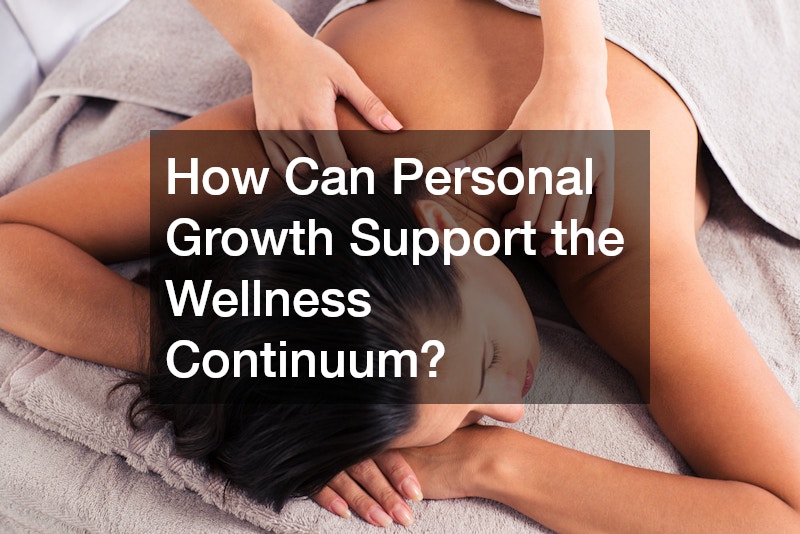
Why Wellness is a Continuum – Steps to a Healthier Lifestyle

In today’s fast-paced world, the concept of wellness has evolved beyond simple measures or occasional health check-ups. Instead, wellness is increasingly recognized as a continuum—a continuous, lifelong journey rather than a definitive endpoint. By understanding wellness as a continuum, we start to perceive it as an evolving aspect of our lives, where each step taken contributes to an overarching journey towards improved health and well-being. This perspective helps to shift our mindset from reaching temporary health goals to nurturing sustainable lifestyle choices. As we delve deeper into the continuum of wellness, it becomes clear that its components are interconnected, with various elements impacting one another. Embracing this continuous endeavor empowers individuals to make informed decisions, which leads to an enhanced quality of life. Wellness, then, is not a destination but a series of choices that, over time, lead to a fuller, more vibrant existence. Acknowledging this broad approach can motivate us to stay committed to long-term health improvements, even when the immediate results aren’t always apparent.
What Does “Wellness is a Continuum” Mean?

The concept that wellness is a continuum speaks to the idea that health is not static, but rather an ongoing process of growth and balance. It challenges the traditional view that wellness can be achieved through singular, isolated events or interventions. Instead, it encourages a holistic approach, where each action is a step towards a larger integration of physical, mental, and emotional health. For instance, people might incorporate regular chiropractic adjustments into their routine to improve mobility. The process is dynamic, requiring constant adaptation to changing needs, circumstances, and life stages. This viewpoint allows individuals to see themselves as active participants in their wellness journey, rather than passive recipients of temporary health interventions. It highlights the importance of creating a foundation of consistent habits that evolve with personal growth. By continuously refining your approach—whether through nutrition, exercise, or emotional resilience—you set yourself up for lasting, positive change. Viewing wellness this way also fosters patience, allowing individuals to appreciate the incremental progress they make, rather than getting discouraged by the desire for immediate results.
Wellness as a continuum means understanding health not as a fixed point, but as a dynamic, ongoing process. It acknowledges that wellness is not achieved through one-time efforts or quick fixes, but through consistent, intentional choices that evolve over time. Each day presents new opportunities to move along the continuum—sometimes forward, sometimes backward—but always with the potential for growth. This perspective allows individuals to move away from the pressure of perfection and instead focus on progress, resilience, and adaptability.
Beginning a wellness journey can feel daunting, but understanding that wellness is a continuum provides a framework for taking the first steps. The key is to start small and gradually incorporate new habits that support long-term health. This might involve simple changes such as increasing daily physical activity, drinking more water, or getting enough sleep. You might also explore wellness services that align with your needs, like IV therapy for hydration and energy. Over time, these small steps build a foundation for sustainable change, making the journey more manageable and enjoyable. Starting with simple, achievable goals can reduce feelings of overwhelm and boost confidence as individuals begin to see and feel positive changes. It’s also helpful to track progress in various ways, whether through journaling, fitness apps, or regular check-ins with health professionals. Gradually expanding your wellness practices to include things like mindfulness, community involvement, or regular health screenings further strengthens your overall well-being. Remember that the key is not to rush but to allow your wellness journey to unfold naturally, step by step, ensuring lasting results.
Unlike traditional models that define health as the absence of illness, the continuum approach includes physical, mental, emotional, and even social and spiritual aspects.
What Role Does Nutrition Play in Wellness?
Nutrition plays a pivotal role in the continuum of wellness, serving as the cornerstone for maintaining optimal physical and mental health. A balanced diet, rich in essential nutrients, fuels the body and mind, providing the energy necessary to engage fully in everyday life. It supports bodily functions, aids in disease prevention, and enhances overall quality of life. Additionally, it is essential to remember that good nutrition doesn’t just mean eating “right,” but also understanding the unique dietary needs of your body as it ages or responds to different lifestyle choices. As you progress on your wellness journey, you may find that certain foods or dietary habits no longer serve you as well as they once did, necessitating a shift in approach. Nutrition is highly personal—what works for one individual may not work for another. If you need assistance, seeking medical weight loss treatments may also help you reach your goals. This understanding empowers people to experiment with various eating styles, while learning what makes them feel their best. With this knowledge, wellness becomes a dynamic journey of discovery, rooted in awareness and intention.
How Does Exercise Fit into a Wellness Continuum?

Exercise is a fundamental component of the wellness continuum, essential for physical vitality and mental well-being. Regular physical activity promotes cardiovascular health, builds strength, and enhances flexibility, contributing to an improved quality of life. It also plays a critical role in mental health, reducing symptoms of anxiety and depression, and boosting mood through the release of endorphins. A strong, resilient body is better equipped to handle daily stress and remain active in all areas of life. To enhance recovery and prevent injury, many individuals supplement their exercise with visiting a specialist, such as a local podiatrist, to improve mobility. Additionally, as part of a continuous wellness journey, exercise isn’t limited to intense workouts. It can include lighter, restorative activities such as walking, yoga, or swimming, which can be just as effective for mental clarity and stress relief. Whether you’re an athlete or someone just starting out, integrating movement into daily life ensures that your physical fitness remains a consistent and rewarding aspect of your wellness continuum.
How Important is Mental Health in the Continuum?
Mental health is an integral piece of the wellness continuum, profoundly impacting how individuals think, feel, and act. Just as physical fitness requires regular attention and care, so too does mental health. Practices such as meditation, journaling, and counseling support emotional resilience and clarity. For some, managing stress or hormonal imbalance may also include wellness services like figuring out how to treat hair loss through dietary supplements or other aesthetic treatments such as facial injections that can boost self-esteem. Prioritizing mental health means addressing more than just the absence of illness—it includes nurturing emotional intelligence, personal growth, and coping strategies. These practices help individuals stay connected to their deeper selves, enhancing overall wellness. As part of the continuum, mental health requires regular check-ins and adjustments—whether that’s seeking professional help when necessary or simply ensuring you make time for self-care in your daily life.
How Can Social Connections Enhance Wellness?
Social connections have profound effects on wellness, acting as the supportive network necessary for navigating the complexities of life. Whether it’s through spending time with friends or joining a wellness-focused group—like a yoga class, or a support group through rehab therapy—human connection offers both emotional and physiological benefits. These relationships provide emotional support, increase feelings of belonging, and reduce stress, all of which contribute to a healthier lifestyle. The benefits of strong social ties go beyond emotional well-being; they can also lead to physical health benefits, such as lower blood pressure and a reduced risk of chronic disease. By investing in these relationships, we improve not only our personal happiness but also our collective well-being. Building and maintaining social connections is an ongoing process that, over time, can provide a source of strength, comfort, and joy as we move through the wellness continuum.
Why is Sleep Critical for Wellness?

Sleep is an essential component of the wellness continuum, providing the restorative processes necessary for maintaining health and balance. Quality sleep regulates hormones, supports brain function, and contributes to emotional and physical recovery. Poor sleep may exacerbate chronic issues like fatigue, which can be relieved naturally or through medical interventions such as local acupuncture. Adequate rest is vital for sustaining energy levels and enhancing overall well-being. Disruptions to sleep can have cascading effects on other areas of wellness, from cognitive function to emotional regulation. Recognizing sleep as a key pillar of wellness allows individuals to prioritize rest just as they would nutrition or exercise. Whether it’s through creating an optimal sleep environment, practicing relaxation techniques, or addressing sleep disorders, quality rest is an indispensable element of any wellness strategy.
How Can Stress Management Improve Wellness?
Effective stress management strategies are crucial for maintaining equilibrium across the wellness continuum. Chronic stress can lead to numerous health issues, including anxiety, depression, and cardiovascular problems. For those experiencing heightened stress responses, services can provide both mental and physical relief. Learning to manage stress effectively can significantly enhance quality of life. By incorporating stress-reducing techniques—like deep breathing, journaling, or nature walks—individuals can build resilience and maintain a healthier baseline. The goal is not to eliminate stress entirely but to develop adaptive strategies that help manage and mitigate its negative effects, allowing your wellness journey to remain steady and sustainable.
What is the Impact of Environment on Wellness?
The environment in which individuals live significantly influences their position on the wellness continuum. Clean air, access to green spaces, and community support all enhance the ability to lead a healthier life. Additionally, modern wellness services like access to vision care specialists, contribute to both functionality and confidence. A clean, organized, and peaceful environment can reduce stress and enhance productivity. Small changes to your surroundings—like bringing nature indoors or maintaining a tidy space—can have a lasting impact. Furthermore, community-level access to services, such as local rehab therapy or wellness workshops, plays a significant role in creating environments that support collective well-being.
How Can Personal Growth Support the Wellness Continuum?

Personal growth is vital to the wellness continuum, encouraging individuals to continuously better themselves and their quality of life. This might include exploring new learning opportunities, engaging in creative pursuits, or taking steps to feel more confident through aesthetic treatments like laser hair removal . It could also involve addressing lingering health concerns by scheduling visits with a doctor or specialist. The pursuit of personal growth challenges individuals to step outside their comfort zones, which can lead to greater resilience and a deeper understanding of oneself. By embracing personal growth, individuals stay motivated to keep evolving on their wellness journey, ensuring that each phase of life brings new possibilities for thriving.
Viewing wellness as a continuum also promotes self-compassion. You may be thriving in one area—like nutrition or exercise—while struggling in another, such as sleep or stress management. This imbalance doesn’t mean failure; it’s simply a reflection of where you are in the moment. The continuum model encourages ongoing evaluation and adjustment, which makes wellness feel more realistic and sustainable.
Conclusion
In conclusion, recognizing that wellness is a continuum offers a powerful framework for understanding health as an enduring, multifaceted pursuit. Embracing this approach involves integrating various lifestyle elements— from nutrition and exercise to mental health and even chiropractic or aesthetic treatments —into a comprehensive strategy for well-being. By acknowledging that each step contributes to an ongoing journey, individuals can make purposeful choices that transform temporary achievements into lasting health impacts. Ultimately, when wellness is perceived as a continuum, it offers the opportunity for lifelong growth and enhancement. This broader understanding encourages individuals to view their health as a dynamic, evolving journey, where every choice and habit plays a crucial role in their overall well-being. By staying committed to the journey, we create a life filled with vitality, resilience, and fulfillment.
Ultimately, the idea of a continuum gives people the freedom to meet themselves where they are. Every step contributes to your unique path toward long-term health and vitality.


